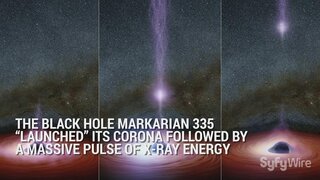Create a free profile to get unlimited access to exclusive videos, sweepstakes, and more!
NASA's Black Hole Visualizations Show What It Might Look Like to Fall into a Black Hole
Ever wondered what it would be like to fall into the supermassive black hole at the center of the galaxy?
In the opening sequence of Farscape, astronaut John Crichton (Ben Browder) straps himself inside the Space Shuttle and launches into orbit. Once in space, the shuttle’s cargo compartment opens up, revealing the experimental spacecraft Farscape-1. Crichton’s mission is to test the ship and lay the foundation for interstellar travel. He fires up the engines and uses the Earth’s gravitational influence to pick up speed, then something goes wrong. A wave of energy distorts radio communication from mission control and Crichton misses the order to abort just before he’s pulled into the open maw of a wormhole.
We’ve never seen a wormhole in real life, we’re not even sure if they actually exist, so the creatives behind Farscape had to imagine what falling into one might look like. If wormholes do exist, it’s possible they look a whole lot like black holes, and in the years since Farscape premiered in 1999, we’ve learned quite a bit about those.
Incorporating the latest information about black holes and the data-crunching talents of a supercomputer, NASA scientists have constructed a collection of new simulations showing what it might look like to fall into a black hole.
For More on Black Holes:
It's Not the Closest Black Hole to Earth, But the Biggest Stellar Mass Black Hole Ever Found Ain't Far
How the Vera Rubin Observatory Will Hunt Down Black Holes
Did J. Robert Oppenheimer Discover Black Holes? Sort of, But Not By Himself
New NASA Simulations Show What Happens When You Fall into a Black Hole
In the distorted spacetime surrounding a black hole, the reliable rules which govern our reality begin to stretch and bend, and things no longer behave the way we might expect them to. We can do the math, crunch the numbers, and calculate what’s happening in the vicinity of a black hole, but the mind strains to visualize an environment so far removed from the African plains where it evolved.
Jeremy Schnittman, an astrophysicist at NASA’s Goddard Space Flight Center, created the simulations with the help of fellow Goddard scientist Brian Powell. The duo used the Discover supercomputer at the NASA Center for Climate Simulation to create two separate simulations, each showcasing a different type of black hole interaction.
“People often ask about this, and simulating these difficult-to-imagine processes helps me connect the mathematics of relativity to actual consequences in the real universe. So I simulated two different scenarios, one where a camera — a stand-in for a daring astronaut — just misses the event horizon and slingshots back out, and one where it crosses the boundary, sealing its fate,” Schnittman said in a statement.
All told, the simulations generated approximately 10 terabytes of data over the course of five days, using just 0.3% of Discover’s processing power. Schnittman estimated that the same simulations would have taken about a decade to perform on a typical laptop. If the complete might of Discover had been bent toward the problem, it could have gotten them done in a little more than two minutes. Each simulation is presented in two formats, the first is an extended presentation with notes to explain what’s happening at each stage of the simulation, as well as enhanced views of the black hole’s photon ring. The second format ditches the explanations in favor of an unadorned simulation, but adds a 360-degree view, allowing you to look around as you fall into a black hole.
In both simulations, a virtual astronaut approaches and interacts with a supermassive black hole comparable to Sag A*, the black hole at the center of the Milky Way. The simulated black hole has an event horizon stretching 16 million miles (25 million kilometers) in diameter and a mass of about 4.3 million Suns. In one simulation, the traveler passes just outside the event horizon, makes a couple of orbits, and slips through the black hole’s gravitational grasp and back into deep space. In the other, the traveler makes a fatal miscalculation, falls beyond the event horizon, and into the abyss.
Farscape is streaming now on Peacock!






























